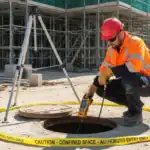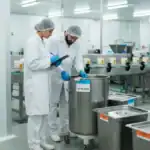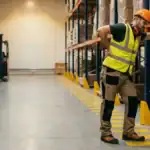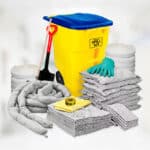
Serious workplace accidents must be investigated. Although bad luck plays a factor, almost every accident is the result of poor management or organisation. Investigating the event and interviewing the people involved is the only way to find and fix the root causes.
This guide outlines how to use an accident investigation form and structure your interviews to ensure you’re gathering the right information.
Key Takeaways
- Serious workplace accidents should be investigated to identify root causes, often tied to poor management or organisation.
- An effective accident investigation form should capture key details like the time, location, people involved and injuries, ideally filled out as soon as possible.
- The investigation team should include senior figures and involve workers for accurate insights into workplace conditions.
- Witness interviews should incorporate open, closed and leading questions, with an emphasis on active listening and psychological safety.
Which Events Should be Investigated
Despite the fact they’re used interchangeably, the terms “accident” and “incident” are separate.
For an event to qualify as an accident, someone must be harmed. If something goes wrong but no one’s harmed, it’s an incident.
Incidents can be further divided into:
- Near misses: Events where someone might have been harmed but wasn’t. These are essentially dress rehearsals for an accident.
- Undesired circumstances: Conditions or situations where the potential for someone to be harmed exists. For example, an untrained worker operating a forklift.
Both accidents and incidents fall under the umbrella term of “adverse events.”
All adverse events are potentially investigation-worthy. If something’s gone wrong, it could be the result of non-compliance. How far you take the investigation depends on the severity of harm that happened (or almost happened) and how likely it is to reoccur.
Serious accidents and near misses should be thoroughly investigated to ensure they’re one-off events. Adverse events that happen often should also be looked at closely, as this is a sure sign of a recurrent issue.
Accident Investigation Training
Our accident investigation training guides users through a step-by-step process for investigating workplace accidents. It helps trainees gather facts, identify root causes, interpret findings and implement measures to prevent future incidents.
What to Include on an Accident Investigation Form
Most accident investigation forms (and incident investigation forms) are similar. At a minimum, they should record:
- Event date, time and location
- Name and job title of the employee(s) involved
- Witnesses
- Description of the event, supported by photos of the scene
- Details of work being carried out before the event
- Injuries sustained
When to Complete an Accident Investigation Form
After an accident, first aid is the priority. But your investigation should start as soon as possible.
In the rush of an accident, people aren’t paying attention to details, so eyewitness accounts won’t necessarily be comprehensive. Memories also fade quickly. Any delays in the accident investigation will hinder your information-gathering.
Who Should be Involved in an Accident Investigation
The people involved in the accident investigation will depend on the nature of the event.
Serious accident investigations should be led by a senior figure, such as a supervisor or even upper management, but with full involvement from your workers.
Workers will be able to give you a more detailed account of their actual work conditions, which is essential to uncover root causes. Involving workers also signals that the investigation is about improving safety, not finding someone to blame. Workers’ testimonies will be more honest if they feel psychologically safe to tell the truth.
The accuracy of your accident investigation form and quality of witness testimonies will also depend on your interviewing skills.
Interviewing Witnesses
To ensure your final accident investigation report is thorough, you need to interview everyone who witnessed or was involved in the event.
Start with basic facts necessary for your accident investigation form, such as time, location and people involved, before moving on to witness interviews.
When planning your questions, follow the acronym PEEPO. It stands for:
- People involved in the event
- Environment where the event happened
- Equipment involved in the event
- Procedures that should have been followed
- Organisational factors relevant to the event
Investigating these five areas will give you a good understanding of the event and, more importantly, what can be done to prevent it from happening again.
Types of Question
There are three types of questions to use in an investigation:
- Open – a question that can’t be answered with a yes or no
- Closed – multiple choice questions or questions that can be answered with yes or no
- Leading – a question that offers an answer for the witness to confirm
Your interview should start with open questions to get an overview of the incident. As the picture becomes clearer, you should move on to closed and then possibly leading questions to confirm the facts.
Take a common workplace accident such as a slip and fall. A typical post-accident witness interview might follow this structure:
- “In your own words, could you describe what happened?” (Open)
- “What happened just before your colleague slipped?” (Open)
- “Was the floor wet?” (Closed)
- “Was a wet floor sign put up?” (Closed)
- “Is it correct you thought the wet floor sign wasn’t noticeable?” (Leading)
While leading questions are valuable to confirm facts or test a witness’ reaction, use them with caution. It’s essential you approach each interview with an open mind. If you think you already know how the accident happened, you might overlook evidence that doesn’t fit your theory.
As a general rule, only use leading questions to clarify what the witness has offered freely.
General Interview Tips
How you manage your interview will affect the quality of witness testimonies. So, follow these general interview tips.
Interview Witnesses Separately
Witnesses can easily be influenced by other people’s version of events, so speak to them individually. It’s also helpful to try and isolate witnesses after the accident for the same reason.
Be Friendly
It’s an interview, not an interrogation. If you’re hostile, witnesses will assume you’re looking for someone to blame and may water down their testimony to avoid incriminating themselves or colleagues. Trying to “catch” inconsistencies or contradictions is also ill-advised, as these mistakes are almost always honest.
Establish a rapport and reinforce you want to understand what happened to make everyone safer.
Use Active Listening
Active listening techniques will help you note every detail and encourage witnesses to talk.
Maintain eye contact as you listen and nod your head. Don’t interrupt, but offer the occasional verbal response to show you’re listening, such as “Okay” or “I understand.”
HSE Guidance
For more guidance on accident investigation forms and questioning, see HSG245 Investigating Accidents and Incidents from the Health and Safety Executive.
Accident Investigation Training
Interviewing witnesses is critical, but it’s just one item on the typical incident investigation checklist.
Our online Accident Investigation Training walks you through every step of an effective investigation. It explains how to speak to witnesses, interpret multiple testimonies and collect facts. It also explains root cause analysis, the critical final step of any investigation that reveals why the accident happened and how it can be prevented.





















